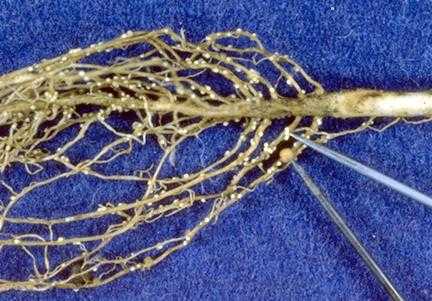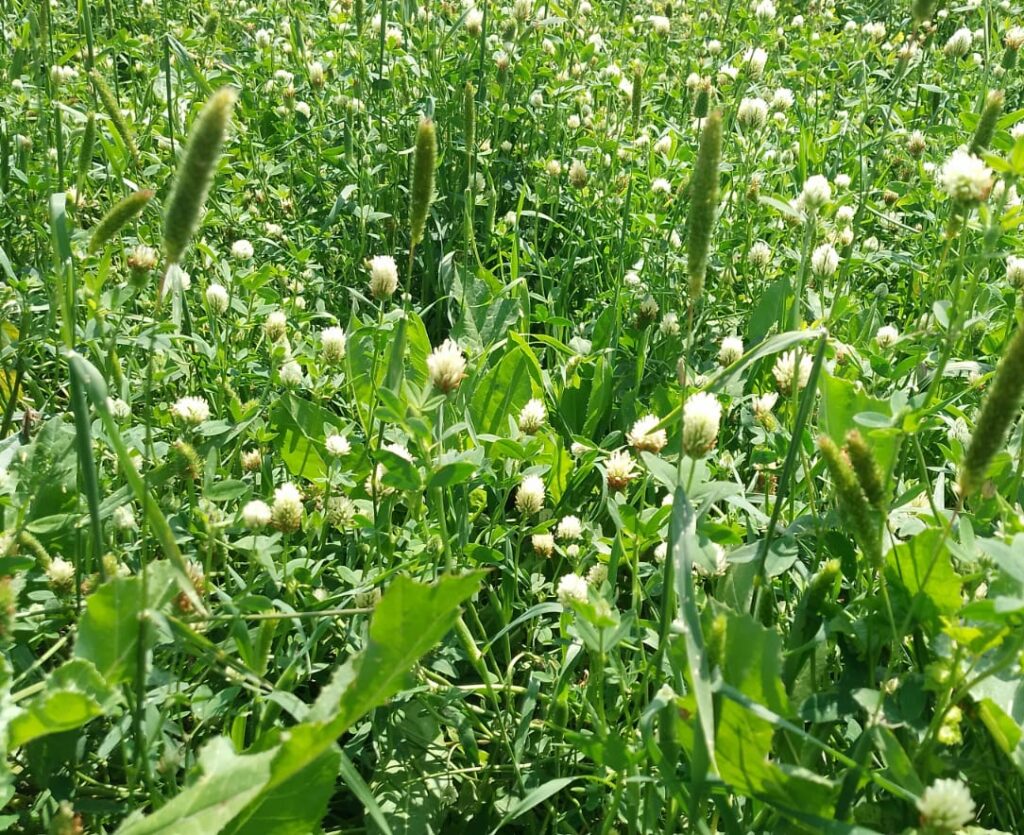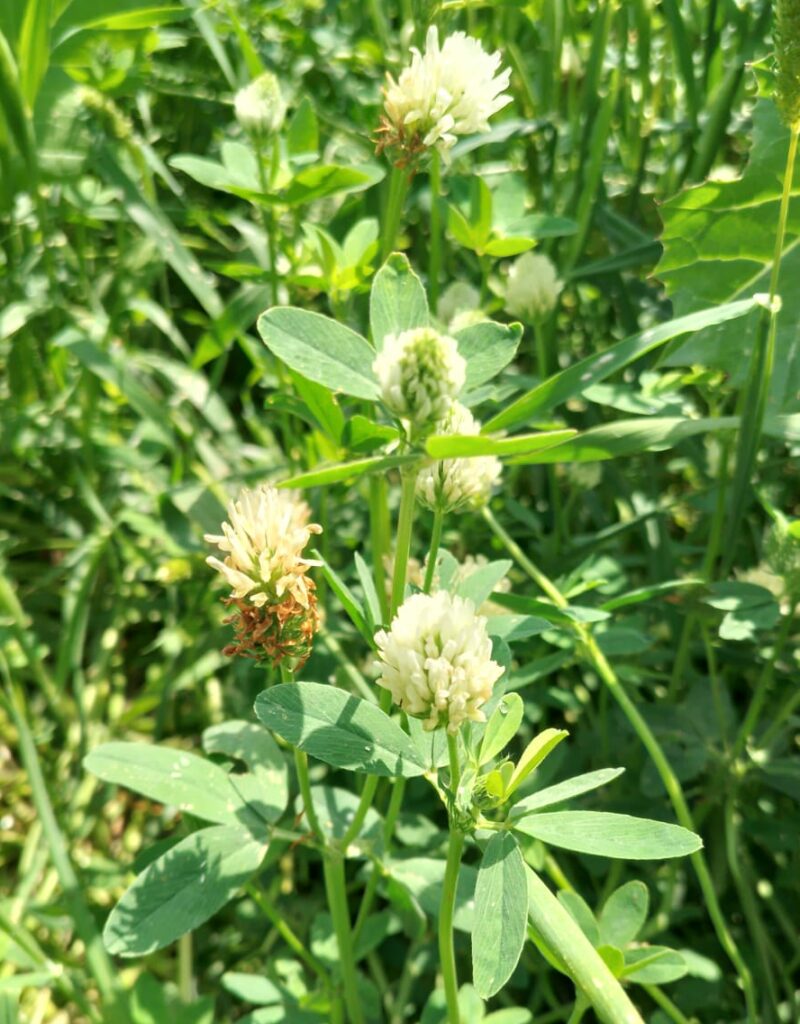CHANGES IN NEXT WEEK’S YOM HA’ATZMAUT DELIVERY SCHEDULE:
- Monday’s boxes will be delivered as usual, Monday, April 24th
- Wednesday’s boxes will be advanced to Tuesday, April 25th
Happy Independence Day!
_____________________________________________
Looking Over Fields of Clover
As reported, the most recent storm hit punctually at the end of our Open Day, waiting patiently and considerately till we’d said our last good-byes, disassembled the equipment, and returned everything to the packing house. We even managed to remove and repack the direction signs before the downpour hit, accompanied by darn impressive thunderstorms and lightning. Just as the sky was cut by sharp streaks of lightning, the thunder shattered the air. All toll, some 80 mm of rain fell on Chubeza’s field in three days. By Thursday we were still packing your boxes to the deafening beat of rain pounding the tin roof of the packing house. Some raindrops even froze and morphed into hail, which really livened up the party.
On days like this, with heavy rainfall over such a short time, we’re grateful for the trend we have been adopting more and more over recent years: growing “cover crops” on the ground in the winter. Those who toured the field with us on the Open Day got a firsthand view of the clover plots we are growing this winter in vacant parts of the fields. Last year we grew wheat, and this year we opted for clover. Both are essentially used towards the same goal of being a “cover crop,” “green manure” or “beneficial crop.”
By definition, cover crops are planted to fill plots which otherwise would have remained bare and exposed over the winter. Essentially, organic farming gives the crops a Sabbatical every year. After we finish growing on a particular plot, we usually let it rest for a few weeks or months (depending on how much land we have and whether we need to hurry and replant the plot). Fortunately, at Chubeza we have reached the valued point where there is more than enough land to allow the plots a good rest between crops. Yet sometimes a field’s winter slumber can boomerang and create more problems than it solves. Torrential rains can also cause major soil erosion, since the earth lacks sufficient roots to hold onto the soil and prevent it from being washed away. A vacant field and an abundance heavenly moisture can also spur an extensive growth of weeds, needing constant trimming.
This is where cover crops come in to save the day.
The clover we sowed last winter just grew naturally, without us expecting it to produce a crop. But by sheer natural coincidence, this clover has generated many gifts. Because it was densely sown, the clover partially filled and even overcrowded the soil, thus (mostly) preventing weeds from developing. By covering the exposed soil, the clover’s deep, strong roots prevented the soil from being washed away by winter rains. These wondrous deep roots also ventilated the soil, improving its texture and delighting the microbes and other creatures partying deep down below. Even above ground, the beneficial, much-needed insects enjoyed a great place to spend the winter season.
The clover awarded us another very valuable advantage: In the depths of the soil, a beautiful process takes place thanks to a phenomenal feature of the legume family to which clover belongs. They know how to “bind nitrogen,” an essential element needed for all plants to grow. Seventy-eight percent of the air is nitrogen, but animals and plants cannot make use of it because this nitrogen’s composition is inaccessible to them (N2, while they need N3). That is where the legumes come in to save the day. Their roots run very deep to penetrate the soil and utilize the nutrients in the lower strata, then proceeding to grow small nodules of bacteria that work symbiotically with the legumes. These bacteria absorb nitrogen from the air caught between the clumps of earth. They then transform it into nitrogenic compounds for the clover plant to absorb from the root and transfer to the rest of its parts.
In return, the bacteria from the clover plants absorb the nutrients that the plant produces (via photosynthesis.) Thus, we get chock-full-of-nitrogen clover. We will harvest it very soon, during the flowering stage. At that point, we will chop the plant and mix it in the soil, thus leaving most of the nitrogen in the earth – plus a considerable amount of organic matter that will greatly enrich the earth’s composition and fertility.
Nitrogen fixing nodules on roots:

Let’s go back to the end of last week. The mass volume of rain was initially welcomed in the field. The aerated soil delightedly lapped up and absorbed the drops, and the clover held everything in place nicely. The hail, on the other hand, did some damage… In the heart of winter, we are prepared for and protected from hail: our leafy vegetables are covered under a thin agril cloth to both protect them from hail damage and allow light and moisture to reach the plants. But come springtime, we remove the covers and let the plants fearlessly, vigorously grow. The confusion of recent years resulting from climate change has caused the weather to become unpredictable and extreme. Over recent years, we have experienced several bouts of heavy rains and late-in-the-season hail when the plants are no longer covered and protected. Those suffering injury in this last round were the lettuce, chard and zucchini. This damage is superficial, so we picked them for you, but if you notice “scratch marks” marring the chard leaves or the zucchini peel, these are simply harmless battle scars from the fierce spring hail.
Wishing everyone fewer upheavals and more balance and calm as the season flows.
Have a good week!
Alon, Bat-Ami, Dror, Orin, Einat, and the entire Chabeza team
___________________________________________________
WHAT’S IN THIS WEEK’S BOXES?
Monday: Lettuce, cabbage, fennel/turnips, beets, carrots, potatoes/fava beans/Chinese peas, coriander/parsley, Swiss chard/kale, tomatoes, cucumbers, onions.
Large box, in addition: Zucchini, garlic, parsley root/celery.
FRUIT BOXES: Oranges/clementinas, red apples/pears, avocados, bananas, pomelit.
Wednesday: Lettuce, cabbage, beets, carrots, potatoes, zucchini/Chinese peas/qweet potatoes, coriander/parsley, Swiss chard/kale, tomatoes, cucumbers, onions.
Large box, in addition: Garlic, parsley root/celery stalk, fennel/turnips/kohlrabi.
FRUIT BOXES: Oranges/clementinas, red apples/pears, avocados, bananas, pomelit.


